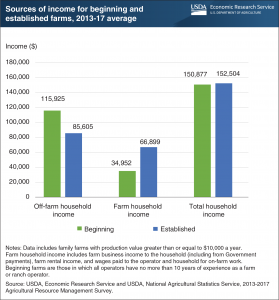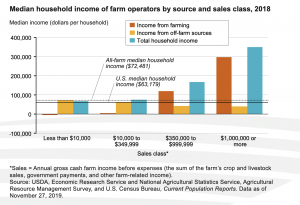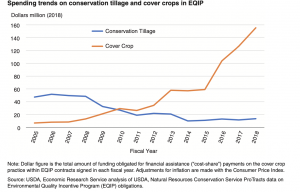Bloomberg's Leah Nylen reported Thursday that "a Colorado judge issued an order temporarily blocking the proposed $25 billion merger of Kroger Co. and Albertsons Cos., which has been challenged by…
Climate Change: An Income Opportunity for Farmers- Perspective from Sec. Vilsack and House Lawmakers
Writing on the front page of Saturday’s Des Moines Register, Donnelle Eller reported that, “U.S. and Iowa farmers need new sources of income, and the work producers need to do to battle climate change can help provide it, newly sworn-in U.S. Agriculture Secretary Tom Vilsack told the Des Moines Register on Friday.
Nearly 90% of farmers no longer make the majority of their money raising crops and livestock, said Iowa’s former governor, who, like millions of other Americans, is working from home — leading the United States Department of Agriculture from Waukee.
“Instead, the bulk of producers have jobs outside of farming.”

The article noted that, “‘In today’s economy, that’s startling,’ said Vilsack, two days into his job leading the 70,000-employee, $146-billion-a-year agency.
“‘It’s incumbent on a secretary of agriculture to explore appropriate ways to create new revenue streams for farmers, so that percentage … isn’t as high as it is today,’ he said.”

Ms. Eller explained that, “As one of his first priorities, Vilsack said he will have the USDA look into the role that the Commodity Credit Corp. can play in mitigating climate change, an issue that President Joe Biden calls a crisis that requires immediate action.
“Former Agriculture Secretary Sonny Perdue used the Depression-era agency’s $30 billion pot to send payments to U.S. farmers to offset losses from trade disputes that began in 2018 with China, Canada and Mexico. ”
“Among the ideas being considered is a carbon bank that would pay producers for using sustainable farming practices such as sequestering carbon in the soil or capturing and reusing methane,” the Register article said.

Meanwhile, the House Agriculture Committee held a hearing on Thursday titled, “Climate Change and the U.S. Agriculture and Forestry Sectors.”
In his opening statement at the hearing, Committee Chairman David Scott (D., Ga.) noted that, “Our farmers, ranchers, and forest managers understand these risks, and they are the first to experience the pressures of a changing climate. But American producers are resilient, and many are already adopting production practices that not only improve productivity but store carbon and reduce emissions in the atmosphere. And yet there is tremendous opportunity to do more. It is incumbent on this Committee to ensure producers have the financial and technical resources they need to understand climate risks, consider mitigation strategies, and receive the support they need to make important investments in their operations.”
Committee Ranking Member Glenn ‘GT’ Thompson (R., Pa.) indicated on Thursday that, “The Farm Bill’s voluntary programs help farmers implement new practices that sequester carbon, reduce emissions, and adopt more energy-efficient farming practices.


American Farm Bureau President Zippy Duvall, one of several witnesses to testify at Thursday’s hearing, indicated in prepared remarks that, “Throughout this process, lawmakers must ensure that any governmental analysis characterizing U.S. crop and livestock systems reflects U.S. agriculture’s leadership globally in sustainable farming practices.”
🌎🌎🔥🔥 New draft @EPA data on #GHG inventory shows U.S. #agriculture represents ONLY 9.6% of total U.S. emissions & #livestock represents ONLY 🐄🐮🐷 4% of total emissions @FarmBureau 👇👇https://t.co/V6p4bUi9GA pic.twitter.com/1W0zt4yPMJ
— John Newton (@New10_AgEcon) February 22, 2021
Meanwhile, DTN Ag Policy Editor Chris Clayton reported on Friday that, “As costs of agricultural disasters rise, some lawmakers see greater hazards in using USDA’s Commodity Credit Corp. fund to encourage climate-smart farming practices.
“The U.S. House Agriculture Committee held a marathon online hearing Thursday, looking at climate change with a focus on the viability of using funds from the annual $30 billion provided to the Commodity Credit Corp (CCC) to develop a carbon bank. The hearing comes as the Biden administration seeks to aggressively engage federal departments, including USDA and its programs, to lower carbon emissions across the U.S. economy.”
At Thursday's House Ag Committee hearing (Climate Change & the U.S. Ag & Forestry Sectors), @RepDustyJohnson discussed carbon bank funding w/ Zippy Duvall, who noted that Sec. Vilsack told him carbon bank funding would not be at the expense of #FarmBill funding (one minute). pic.twitter.com/snATfvzWZb
— Farm Policy (@FarmPolicy) February 27, 2021
The DTN article stated that, “Duvall said the new Agriculture Secretary Tom Vilsack assured him any funding for a carbon bank would not come out of traditional commodity programs.
“Duvall also said the CCC fund still might not have enough borrowing authority to help create a carbon bank. AFBF supports raising that to $68 billion a year.
“‘The borrowing authority of CCC is not nearly high enough and we support raising that level to $68 billion,’ he said.”
In an exchange w/ Zippy Duvall at Thursday's House Ag Committee hearing (Climate Change and the U.S. Ag & Forestry Sectors), @RepDustyJohnson discussed potential transaction costs associated w/ a carbon bank (one-minute). pic.twitter.com/eK43lrFYFp
— Farm Policy (@FarmPolicy) February 27, 2021
Mr. Clayton added that, “Rep. Dusty Johnson, R-S.D., was one of several GOP lawmakers who expressed doubts about a USDA carbon bank. Johnson said he understood transaction costs could be high. Under some analysis, just 10% of the revenue would go to producers, he said.”
Friday’s DTN article pointed out that, “Biden’s climate plan calls for a net-zero emissions economy by 2050, with agriculture helping lead the way.
At yesterday's @HouseAgDems hearing ("#ClimateChange and the U.S. Agriculture and Forestry Sectors"), Committee Chair @repdavidscott pointed out that #farmers will have the inside "pole position" on "our whole response to climate change."
— Farm Policy (@FarmPolicy) February 26, 2021
* 90-second clip. pic.twitter.com/YfPe61Iutp
“Similar policies are happening across Europe as well. Europe’s largest farm organization, Copa Cogeca, on Wednesday expressed its support for an agricultural carbon market under the new EU Strategy on Adaptation to Climate Change, which includes a goal ‘to develop a certification mechanism for carbon removals.'”





